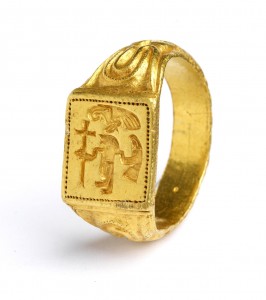Saffron Walden Museum
A remarkable archaeological find has been secured by Saffron Walden Museum, thanks to grants from the Essex Heritage Trust and several national funding organisations. The large gold finger ring, measuring up to 27mm across and weighing over 20 grams, was found by a metal-detectorist in November 2011 in Uttlesford district (north-west Essex) and reported under the Treasure Act 1996. It immediately aroused the interest of specialists in the Anglo-Saxon period, and was featured in ITV’s first series of Britain’s Secret Treasures in July 2012. Following a lengthy process of examination, inquest and valuation, the ring was acquired by Saffron Walden Museum in December 2013, after a concentrated four-month fund-raising campaign.
This find is of exceptional importance not only as an early Anglo-Saxon ring of very high and possibly royal status, but also as a signet ring with an engraved bezel. The bezel features a human figure who is apparently naked except for a belt, walking to the left and carrying a cross-headed staff in one hand and a small bird-of-prey on the other. Above the figure is a larger bird-of-prey, depicted in a style characteristic of early 7th century art which is best known from its use on high-status objects such as those from the royal burials at Sutton Hoo, Suffolk or Taplow, Berkshire. The ring’s shoulders are covered with relief decoration which have been interpreted as schematic animal heads. The hoop is divided into panels featuring birds with crossed wings, either side of a panel of symmetrical interlace ornament. Experts have dated the ring to around 580 – 650 AD, the period which spans the rise of the early Anglo-Saxon kingdoms, including Kent, Essex and East Anglia; St Augustine’s mission and the introduction of Christianity, and the remarkable royal burials at Sutton Hoo and Prittlewell, Southend. The derivation of the motifs on the ring and what they represent has already been the subject of expert debate. Put simply, their combination of late Roman-Christian and pagan north-European imagery seems to encapsulate this formative period of English history when the emergent Anglo-Saxon kingdoms were coming under the influence of Christian missions and Continental politics.
The location of the find-spot is being protected. The site has been thoroughly investigated, but there was nothing to provide a context for the ring – it appears to have been a solitary loss, and not from a burial or settlement. While the identity of the ring’s original owner, and the circumstances which led to its loss in north-west Essex, remain matters for speculation, it will continue to fascinate visitors and attract further study in Essex and at national level.
(Image taken by Steve Bond and ©Saffron Walden Museum)

